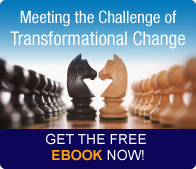Change is hard. Enterprise-wide, transformational change is geometrically more complex. While big changes such as Agile, Mergers & Acquisitions and Shared Services may make strategic sense for an organization, there is no doubt they can be time consuming and incredibly challenging. 
Agile, Lean, Digital Transformation, Culture Change and many other similar big changes are all 2nd order, frame-breaking change. People, processes and technology will all be impacted. Simply put, your organization will be doing different things in completely different ways. Large-scale, highly disruptive changes like this cannot be done incrementally. Once you take these leaps, you can’t change your mind and go back to the old ways.
Sound daunting? Yes. But, by employing a structured change management process (like the AIM Change Management Methodology) big changes can be managed and ultimately…successful.
Critical Measures of Success
The end goal of every change no matter how big or small should be full benefit realization. That’s why I am amazed that so many organizations are still getting to “go live,” declaring a project complete and thus, successful. The fact of the matter is, getting to “go live” has nothing to do with being successful. Sure, things may be up and running, but if you look around the organization what has actually changed?
The truth is until you get to sustained behavior change you will not get the financial and other benefits the change is intended to achieve. There is no change unless people change their behavior. And that doesn’t happen at launch!
So, instead of declaring success at "go live," organizations need to re-frame their definition of success to include all 5 of these critical success measures:
- It’s delivered on time
- It’s delivered on budget
- The technical objectives are achieved
- The business objectives are achieved
- AND it meets the human objectives that have been established for the change
When a project is delivered on time, on budget and the technical objectives are met, that’s successful Installation. To reach successful Implementation, the business and human objectives must also be met. These human objectives are the behaviors you seek to see in the future. In other words, what will people be doing differently in the future?
Best Practices for Implementing Big Changes
So, how do you ensure the human objectives of a big change are being met? Here are a few best practices from the AIM Change Management Methodology to ensure success when a big change is on the agenda:
- Use a structured change management methodology like AIM. By using a structured approach to change, an Implementation Plan will be built to manage the human elements of the change with the same rigor and discipline as the technical side of the project.
- Create a clear, compelling definition of the change. In order to properly define the change, you need to identify the behavior gap between the current state and the future state. In other words, what are people doing now and how should they behave after the change? Remember transformational change can’t be accomplished through a list of corporate-speak platitudes. The new behaviors must be identified for each Target group impacted by the change.
- Generate a cascade of committed Sponsors. The fastest way to transform is by having leaders change the way in which they lead the organization, most importantly with their own direct reports. Sponsorship is the demonstrated Expressed, Modeled and Reinforced commitment of all the leaders who have direct reports that are impacted in some way by the change. This is the start of the cascade of Sponsorship I talk so much about. This cascade of behavioral commitment is the single most important factor in the speed and success of your transformational change project.
- Put radically different Reinforcements in place. Reinforcement drives behavior change. Every time you see a pattern of behavior replicated over-and-over, there either is or was a reward for that behavior. Reinforcement is not just your performance appraisal process or pay and compensation. Leaders reinforce all day long, every day. You can’t continue to reinforce the same old values and behaviors in your organization and expect to get change, let alone transformation. During a transformational change, if you’re applying the same reinforcements as in the past, you will just get more of the “same.”
Enterprise-wide, extreme changes are complex. But when you follow a repeatable process like the Accelerating Implementation Methodology (AIM), you will minimize business disruption, increase the speed of implementation, and manage the cultural and organizational risks that are always present. That’s what I call success!
PS - For more information about this topic, I will be holding a Masterclass at #ACMP2019 in Orlando entitled: Enterprise Change is Complicated! Critical Success Factors for Culture, Agile, Lean, ERP’s, M&A’s and Other Big Changes. The session is scheduled for Monday, April 29th at 10:45am. Pre-registration is required.
If you can't attend the Masterclass, or prefer a private meeting, please contact info@imaworldwide.com to set up a time. I will also be at the opening reception if anyone would like to say hello!
I look forward to seeing you all next month!


